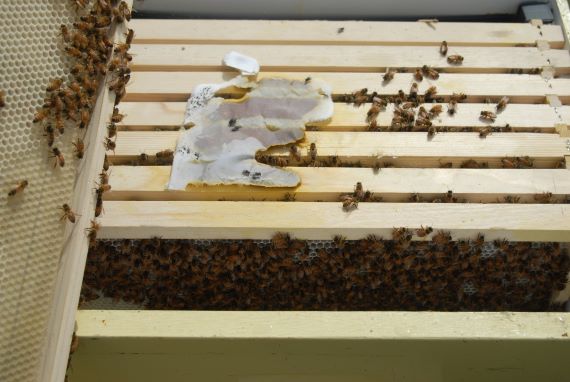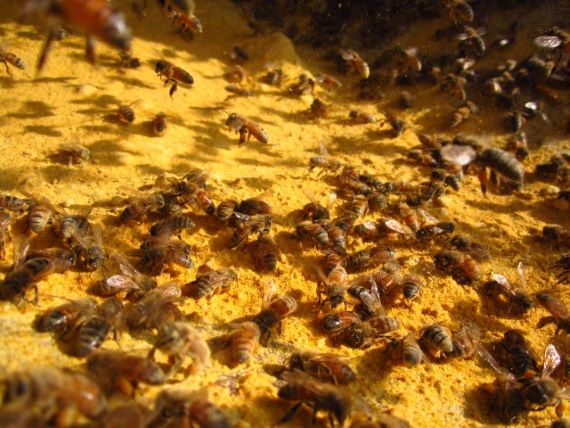
Supplementary feeding
Substitutes and supplements
To stimulate brood rearing, beekeepers have a choice: they can either move hives onto breeding conditions prior to major honey flows, taking advantage of various flowering species, or they can artificially stimulate their hives with supplementary feeding. This is largely an economic decision as there are costs associated with both moving bees and feeding substitutes and supplements. The term ‘supplements’ suggests that there is already some naturally occurring pollen and/or nectar in the area for the bees and the beekeeper is making up the shortfall by feeding the hive strategic supplements. Supplements should contain the nutritional components that are deficient in the field as well as make up the required volume a colony may consume. ‘Substitutes’ suggests that either nectar or pollen, or both, are completely deficient in the field.
See Fat Bees Skinny Bees, A manual on honey bee nutrition for beekeepers by Doug Somerville
Carbohydrate supplements
If a colony is critically short of stored honey or requires stimulation, feeding sugar syrup to hives will either keep the hive alive (as in winter) or stimulate the colony to rear more brood. Large quantities of thick syrup are suitable for feeding to bees to store for winter, whereas small quantities of thin syrup fed regularly stimulates the colony to expand the brood area.
“Feeding sugar in syrup form is the most popular and probably most effective method”
Different sugar feeding strategies can be used to support the survival or stimulation of honey bees.
Primefact 1343 Feeding sugar to honey bees (PDF, 685.71 KB)
In many cases feeding sugar syrup to a hive increase the number of field bees foraging for pollen. This may be of benefit in crop pollination situations where bees collecting pollen are more efficient pollinators than nectar collecting bees. Some crops do not provide significant quantities of nectar, and stimulation from sugar syrup may significantly increase the overall pollination efficiency of a colony of bees. A three year trial in New Zealand indicated that feeding one litre of syrup per day per colony in the morning resulted in a greater amount of pollen being collected by bees. If it is not consumed immediately, feeding sugar syrup requires bees to process the syrup by reducing the moisture content and storing it in combs.
Feeding sugar syrup:
- Can stimulate bees
- Cost efficient
- Bees are more attracted to sugar syrup than honey
- Promotes longer lived adult bees compared to feeding honey
Honey as a supplement
Feeding honey to a hive in some circumstances is possible, although bees do not seem to do as well on honey compared to sugar syrup. It may be better financially for the beekeeper to sell the honey and buy sugar. If honey has candied in combs then these combs can be stored and given to colonies as required. Honey should only be fed back to the same colony where it has come from, unless the honey has been sterilised by gamma irradiation!
There are risks associated with feeding honey to colonies, the main one being the possible spread of American foulbrood (AFB). AFB spores are readily transferred in honey, so you must know the source of any honey you are feeding to bees and be mindful that AFB spores will persist in honey and elsewhere for 35 years or more. It is important that the honey should not contain any bee disease organisms.
Feeding honey to a hive is not desirable if the aim is to stimulate the hive. The colony will reduce the brood area, the bees will become more defensive and robbing activity will increase.
Feeding honey:
- Risk of disease transmission
- Does not stimulate bees
- Can make bees more defensive/aggressive
- Can promote robbing behaviour
- Not economical given the lower cost of sugar feeding


Protein supplements
If the purpose is to stimulate the colony and increase population numbers, then attention to the protein components of the diet is also essential. Protein supplements come in a variety of forms. Some beekeepers trap pollen in the field and store for feeding back to their hives at a later date. Protein fed to bees should contain at least 5% bee-collected pollen to make the mixtures more attractive to the bees and to stimulates the hypopharyngeal glands of older nurse bees to produce worker and royal jelly for feeding to young developing larvae and the queen bee.
When feeding protein supplements consider:
- Attractiveness to bees
- Nutritional value
- Availability of the source
- Cost
- Toxic substances (such as high levels of oils, salt, and starch)
The need to feed bee-collected pollen or protein supplements will depend a lot on the amount of brood in the hive, the amount of stored pollen, current and future nectar and pollen conditions and demands to be placed on the hives. If hives are critically short of pollen and either have a large brood nest or are expanding their brood nests, then the beekeeper needs to consider the various options available to avoid a reduction in bee population numbers due to shorter lived bees. This ultimately results in weaker colonies that are not suitable for working honey flows or crop pollination. One option is to physically move the apiaries onto a naturally occurring pollen source. If this is not feasible due to the cost and inconvenience of moving the bees or because a suitable pollen source is not available, then feeding pollen or protein substitutes may need to be considered.
“Prolonged feeding of protein supplements will result in short-lived bees”
Two generations of brood can be satisfactorily obtained before this situation develops. Feeding supplements or pollen should begin approximately 6 weeks prior to an expected natural source of pollen being available. Various sources of information suggest that feeding a protein supplement will decrease the amount of foraging for pollen by field bees. On the other hand, it has also been stated that when a natural source of pollen becomes available, consumption of pollen substitutes diminishes. There may well be a combination of these two factors occurring concurrently. The presence of drone brood has been one measure of the colony’s nutritional status, since drone brood appears during periods of ample pollen availability and is reduced when pollen is in short supply.
Protein supplements can be fed as dry powder, which must be very finely milled (under 500 microns) so that bees can collect it. The powder can also be mixed with sugar syrup and fed as a patty. Open feeding (usually powder) or in-hive feeding (usually patties) are effective methods.
Pollen as a supplement
Naturally collected pollen is the best source of protein for honey bee nutritional requirements but this pollen can vary in protein according to the floral source. Protein levels vary from 2.5% to 61%; the minimum protein level required for honey bees is 20%. If the aim is rapid breeding and expansion of the hive population to work a heavy honey flow, crude protein levels of 25–30% are required. The balance of amino acids is also important (see section on nutritional requirements of honey bees).
Thus, a single naturally occurring pollen may be deficient in one or more components required for honey bee nutrition. Adequate nutritional requirements are met when the colony is collecting pollen from a number of different floral sources and sufficient quantity is maintained. One colony over a 12-month period will consume 25–50 kg of pollen, depending on the size of the colony and the availability of pollen. Storing pollen in combs to feed back to colonies at a later date has been practised for many years. This involves removing combs of pollen from when the colony is storing a large surplus and placing these combs back into colonies during periods of dearth. Storing pollen can become a problem due to waxmoth and mouse damage. It is advisable to store pollen frames in a freezer or cold room. Alternatively, pollen traps can be placed on a beehive where the bees are forced to enter through a series of screens that scrape the pollen off the back legs of the returning field bees and the pollen is caught in a collection tray underneath. The pollen is then stored by either freezing or drying the pollen. Trapping pollen during the swarming season has been shown to reduce the swarming incidence of colonies.
For more details on how to trap and store pollen see Primefact 1257 Removing honey from the hive (PDF, 269.62 KB).
Pollens with high nutritional values should be trapped in preference to pollen with lower values. If the nutritional value is high enough, pollen is quite often fed directly back to a hive when required without the addition of other substances.
Caution:
As with honey, pollen can carry and transmit bee diseases. If trapping and storing pollen yourself, check that hives are disease free; if you are buying pollen, use only pollen that has been sterilised by gamma irradiation.
Nutrition during drought and fire
Management of bee nutrition in drought and fire affected areas may require supplementary feeding to prevent starvation. In this case, the provision of sugar syrup could be one strategy, although syrup, whatever the concentration, behaves as a stimulus to the colony which may not be a desirable outcome. Dry sugar has been demonstrated to provide the necessary carbohydrate both during winter and drought conditions and is possibly the technique of choice if stimulating the colony is to be avoided.
For more information see Management of bee nutrition in drought and fire affected areas
REFERENCES
Crane, Eva (1975). Honey — a comprehensive survey. International Bee Research Association.
DeGroot (1953). ‘Protein and amino acid requirements of the honey bee’, in Physiol. Comparata et Oecolog.
Kleinschmidt, GS (1986). Research papers, QAC. Laws, Qld.
Seeley, T. D. (1995). The Wisdom of the Hive: The Social Physiology of Honey Bee Colonies. Cambridge, MA: Harvard University Press .

